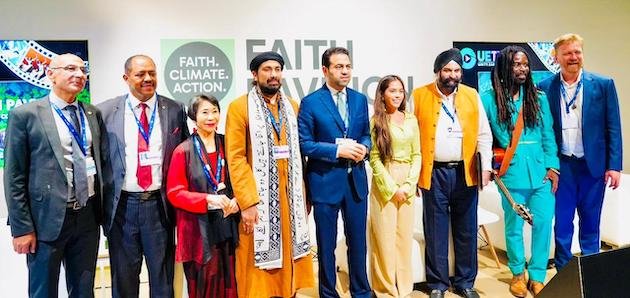
[ad_1]

DUBAI, Dec 07 (IPS) – For the primary time at COP28, religion has a pavilion alongside science, know-how, nations, and philanthropy, permitting non secular leaders from all around the world to debate the potential for utilizing religious deserves to guard the earth from local weather change.
Syed Salman Chishty, representing India’s largest religious shrine, Ajmer Sharief, gave IPS the rationale for the pavilion: “As we collect at COP28, we’re reminded of the significance of justice and compassion as guiding ideas for transformation—that is the overarching theme of the occasion—the necessity for real change rooted in common values present in various cultures.”
The Ajmer Sharief shrine is the tomb of Moinuddin Chishti, a Thirteenth-century Iranian Sufi saint and thinker who made India his closing abode. Individuals of all faiths venerate his shrine, which is commonly described as an emblem of India’s pluralism.
The Religion Pavilion at COP28 has additionally introduced collectively heads of nations, non secular leaders, scientists, and activists in a united entrance in opposition to the looming risk of local weather change. Among the many dignitaries current at its opening was Indian Prime Minister Narendra Modi, who stood shoulder-to-shoulder with religious luminaries, local weather activists, and representatives of world suppose tanks.
The Coalition of Religion Companions and the USA each supported the initiative, which has co-hosts just like the UAE’s Ministry of Tolerance and Coexistence, Decide Mohamed AbdlSalaam of the Muslim Council of Elders in Abu Dhabi, and Iyad Abumoghil, Director of Religion for Earth on the UN Setting Program (UNEP) in Nairobi.
The Religion Pavilion at COP28 goals to faucet into the ability of religion communities and non secular establishments to handle the local weather disaster. A various array of leaders congregated to discover the potential of spirituality in combating environmental challenges. The discussions weren’t merely about insurance policies and applied sciences; moderately, they delved into the profound realms of justice, compassion, and acutely aware transformation.
The Name to Consciousness occasion panel featured worldwide delegates corresponding to Audrey Kitagawa, founder and President of the Worldwide Academy for Multicultural Cooperation within the USA; Ben Bowler, Government Director of Unity Earth in Australia; Ambassador Mussie Hailu of the United Non secular Initiative in Ethiopia; Surender Singh Kandhari, chair of Gurudwara Gurunanak Darbar in Dubai; and Rocky Dawuni, a musician and International Peace Ambassador of UNEP from Ghana.
The leaders on the Religion Pavilion, says Chishty, emphasised the cultivation of three attitudes in the direction of nature: sunlight-like grace, river-like generosity, and earth-like hospitality. These attitudes, they argued, may function a blueprint for people to combine into their day by day lives. By doing so, they believed that these ideas may bridge variations and divisions within the collective service of others.
“The decision for unity in range echoed by way of the discussions, impressed by the teachings of our saint, Khwaja Garib Nawaz, also referred to as the patron saint of the poor. It was a celebration of the interconnectedness of humanity and nature, urging everybody to look past borders and backgrounds within the pursuit of a shared purpose: combating local weather change,” Chishty mentioned.
He added that the Religion Pavilion at COP28 turned a platform not just for dialogue but additionally for the formulation of actionable methods.
“The leaders acknowledged the urgency of the state of affairs and dedicated to translating the discussions into tangible initiatives. The mixture of religious knowledge, scientific data, and the collective will of various religion communities generated a way of hope and function,” Chishty.
In keeping with him, the occasion marked a departure from standard approaches to local weather change discussions.
“It acknowledged that addressing the environmental disaster requires greater than technological developments and coverage adjustments; it necessitates a profound shift in consciousness and values. The Religion Pavilion was a testomony to the understanding that religion, when aligned with a shared imaginative and prescient, has the potential to drive transformative change on a worldwide scale,” Chisty mentioned.
In keeping with him, as soon as the deliberations within the Religion Pavilion had been concluded, the individuals left with a renewed sense of function and a shared dedication to take concrete actions within the struggle in opposition to local weather change.
“The fusion of religion, science, and activism paved the best way for a brand new chapter within the international response to environmental challenges—a chapter written with the ink of unity, compassion, and a deep reverence for the interconnectedness of all life on Earth,” Chishty concluded.
IPS UN Bureau Report
Follow @IPSNewsUNBureau
Follow IPS News UN Bureau on Instagram
© Inter Press Service (2023) — All Rights ReservedOriginal source: Inter Press Service
[ad_2]